How Kenyans help themselves and the planet by saving mangrove trees
Conserving the carbon-storing forests is good for the environment and village growth

Mwatime Hamadi, a tour guide at Gazi Ecotourism Ventures in Kenya, explains how dropping the propagule from her hand into the soil below will germinate a new mangrove plant.
G. KAMADI
- More than 2 years ago
On the fringe of Kenya’s Gazi village, 50 kilometers south of Mombasa, Mwatime Hamadi walks barefoot on a path of scorching-hot sand toward a thicket of trees that seem to float where the land meets the Indian Ocean. Behind her moves village life: Mothers carry babies on their backs while they hang laundry between palm trees, women sweep the floors of huts thatched with palm fronds and old men chat idly about bygone days under the shade of mango trees.
Hamadi is on her way to Gazi Forest, a dense patch of mangroves along Gazi Bay that coastal residents see as vital to their future. Mangroves “play a crucial role in safeguarding the marine ecosystem, which in turn is important for fisheries we depend on for our livelihood,” she says as she reaches a boardwalk that snakes through the coastal wetland.
Hamadi is a tour guide with Gazi Ecotourism Ventures, a group dedicated to empowering women and their community through mangrove conservation. This group is part of a larger carbon offset project called Mikoko Pamoja that has taken root and is now being copied farther south on Kenya’s coastline and in Mozambique and Madagascar.
Through Mikoko Pamoja, residents of Gazi and nearby Makongeni are cultivating an economic ecosystem that relies on efforts to preserve and restore the mangrove forests. Revenue from carbon credits sold plus the money Hamadi and others earn from ecotourism are split between salaries, project costs and village improvements to health care, sanitation, schools and more.
Mikoko Pamoja, launched in 2013, is the world’s first mangrove-driven carbon credit initiative. It earned the United Nations’ Equator Prize in 2017, awarded for innovative solutions to poverty that involve conservation and sustainable use of biodiversity.
“The mangrove vegetation was a thriving, healthy ecosystem in precolonial times,” says Ismail Barua, Mikoko Pamoja’s chairperson. During British rule, which stretched from the 1890s to 1963, the colonial government issued licenses to private companies to export mangrove wood. They did this without community involvement, which led to poaching of trees. Even after Kenya gained independence, mangroves were an important source of timber and fuel for industrial processes, main drivers of extensive destruction of the forests.
Today, mangrove restoration is helping the region enter a new chapter, one where labor and resources are well-managed by local communities instead of being exploited. “The community is now able to run its own affairs,” Barua notes. Through innovative solutions and hard work, he says, “we’re trying to bring back a semblance of that ecosystem.”
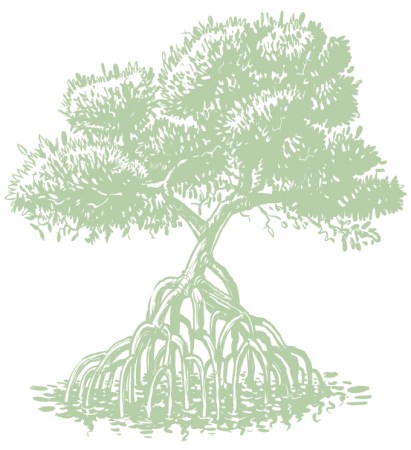
“The mangrove vegetation was a thriving, healthy ecosystem in precolonial times.…We’re trying to bring back a semblance of that ecosystem.”
Ismail Barua
A fragile carbon sponge
The dominant mangrove species in Gazi Forest is Rhizophora murcronata. With oval, leathery leaves about the size of a child’s palm and spindly branches that reach to the sun, the trees can grow up to 27 meters tall. Their interlaced roots, which grow from the base of the trunk into the saltwater, make these evergreen trees unique.
Salt kills most plants, but mangrove roots separate freshwater from salt for the tree to use. At low tide, the looping roots act like stilts and buttresses, keeping trunks and branches above the waterline and dry. Speckling these roots are thousands of specialized pores, or lenticels. The lenticels open to absorb gases from the atmosphere when exposed, but seal tight at high tide, keeping the mangrove from drowning.
The thickets of roots also prevent soil erosion and buffer coastlines against tropical storms. Within these roots and branches, shorebirds and fish — and in some places, manatees and dolphins — thrive.
Mangrove roots support an ecosystem that stores four times as much carbon as inland forests. That’s because the saltwater slows decomposition of organic matter, says Kipkorir Lang’at, a principal scientist at the Kenya Marine and Fisheries Research Institute, or KMFRI. So when mangrove plants and animals die, their carbon gets trapped in thick soils. As long as mangroves stay standing, the carbon stays in the soil.
Robust estimates of mangrove forest area in Kenya before 1980 are not available, Lang’at says. However, with the clear-cutting of mangrove forests in Gazi Bay in the 1970s, he says, the area was left with vast expanses of bare, sandy coast.
Other parts of the country experienced similar losses: Kenya lost up to 20 percent of its mangrove forests between 1985 and 2009 because no mechanism existed for their protection. The losses had a steep price: Just as mangroves absorb more carbon than inland forests, when destroyed, they release more carbon than other forests. And since the mangroves provided habitat and shelter for fish, their destruction meant that fishers were catching less.
20
percent
Amount of mangrove forest Kenya lost between 1985 and 2009
Recognizing this high cost, as well as the ecosystem’s other benefits, Kenya’s government ratified the Forest Conservation and Management Act of 2016, a law protecting mangroves and inland forests. Cutting down mangroves is now banned throughout the country, except in very specific areas under very specific circumstances.
Available data suggest that Kenya’s rate of mangrove loss has declined in the last two decades. The country is now losing about 0.65 percent of its mangrove forest annually, according to unpublished evaluations conducted in 2020 by KMFRI. Since the turn of the millennium, global mangrove deforestation has slowed as well, hovering between a loss of 0.2 and 0.7 percent per year, says a 2020 study in Scientific Reports.
Mikoko Pamoja offers hope for turning around those declines. The project, whose Swahili name means “mangroves together,” has its roots in a small mangrove restoration effort that started in 1991 in Gazi Bay, spearheaded by KMFRI. The effort evolved into a scientific experiment to see what it would take to restore a degraded ecosystem. It attracted collaborators from Edinburgh Napier University, Europe’s Earthwatch Institute and other organizations across Europe.
Now, Gazi Forest boasts 615 hectares of mangrove forest, including 56,000 individual seedlings planted by the community. Plans to plant more mangrove trees — at least 2,000 per year — are in the works.
Carbon keepers
Compared with other major forest types, mangrove forests capture and store more carbon dioxide, especially within tree roots and surrounding soil.
Carbon storage in various forest types
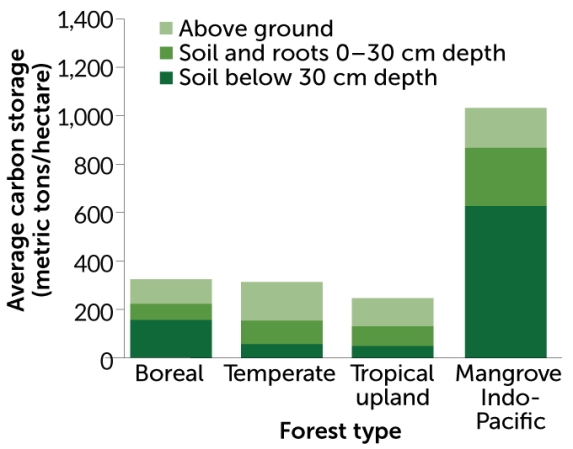
Creating carbon credits
Gazi Forest siphons carbon from the atmosphere at a rate of 3,000 metric tons per year, says Rahma Kivugo, the outgoing project coordinator for Mikoko Pamoja. These aren’t merely ballpark numbers: To sell the carbon offsets collected by Mikoko Pamoja, forest managers must calculate the amount of carbon stored by mangroves.
Volunteers venture into the forest twice a year, checking on 10 selected 10-square-meter plots in the wild forest and five plots in planted forest. Workers measure the diameter of mature trees at an adult’s chest height. They then estimate the trees’ height. Finally, they classify young trees as knee-height, waist-height, chest-height and higher.
From these observations, researchers estimate the volume of mangrove material above ground in each plot and extrapolate for the whole forest area.
Once they have an idea of the volume of plant material above ground, team members can estimate root volume below ground using a standardized factor specific to mangrove forests, says Mbatha Anthony, a research assistant at KMFRI in charge of carbon accounting. Even though mangrove forests store a lot of soil carbon, the project calculates carbon stored only by the tree itself because “calculating soil carbon is a resource-intensive undertaking for a small project like Mikoko Pamoja,” Anthony says.
With an estimate of the total volume of biomass in the forest in hand, “we can then translate that into tons of carbon,” says environmental biologist Mark Huxham of Edinburgh Napier University, who helps Mikoko Pamoja with its calculations. In general, 50 percent of aboveground biomass is carbon. Below ground, 39 percent of biomass is carbon.
The amount of carbon stored by Gazi Forest is then relayed to the Plan Vivo Foundation, a group based in Scotland that certifies carbon calculations. Once its calculations are certified, Mikoko Pamoja receives Plan Vivo Certificates, or PVCs.
One PVC is equivalent to one metric ton of carbon dioxide emission reductions. These PVCs are submitted to the Association for Coastal Ecosystem Services — an organization that markets carbon credits for Mikoko Pamoja and similar projects. Through ACES, Mikoko Pamoja’s PVCs can then be purchased by anyone who wishes to offset their carbon emissions.
Roughly 117 hectares of Gazi Forest have been demarcated for the sale of carbon credits. “Mikoko Pamoja generates approximately $15,000 annually from the sale of carbon credits,” Anthony says. From 2014 to 2018, the project generated 9,880 credits — 9,880 tons of avoided carbon dioxide emissions.
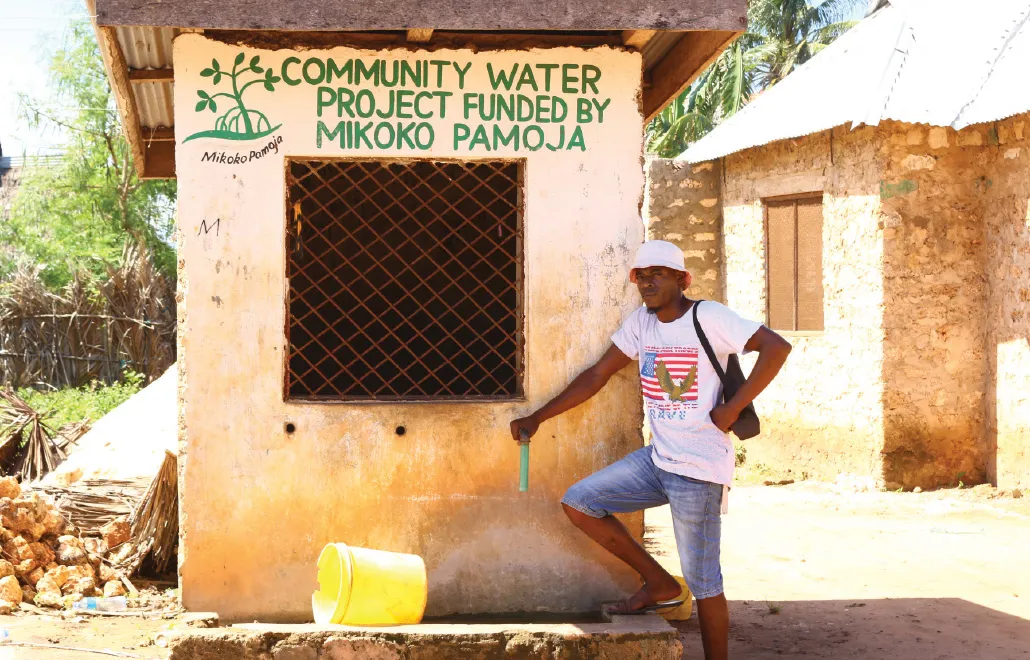
A community at work
Mikoko Pamoja sells carbon credits at more than $7 per ton. Revenues get split in a clearly defined manner, according to what residents decide are pressing needs of Makongeni and Gazi villages. Around 21 percent pays wages of residents involved with Mikoko Pamoja. And “more than half of what is earned goes toward community projects,” Kivugo says.
In total, about $117,000 has gone to community projects since Mikoko Pamoja was founded. These projects include donating medicine to health clinics and textbooks to schools and digging clean water wells. Plans are under way to revive a windmill in Gazi for pumping water and renovate Makongeni’s primary school.
“The need in the community is great. So carbon trading is unlikely to meet all the needs,” Huxham says. But the funds make a significant contribution to local livelihoods, which primes the community to support conservation, he says.
The approach seems to be working. On a winding path into the forest, visitors encounter a signboard, with large letters in Swahili declaring, “Take note! This is a Mikoko Pamoja area protected by the community. Littering is prohibited! Trimming trees is prohibited!”
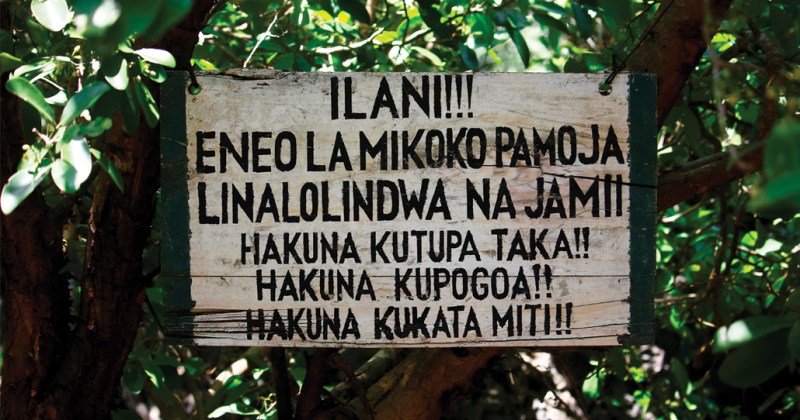
Active community participation is central to Mikoko Pamoja’s success. Not only do community members plant mangrove seedlings and survey trees to gauge carbon storage, community scouts monitor the health of this ecosystem.
Scouts clean up litter within the forests and survey the forest’s biodiversity. From a wooden watchtower above the forest, scouts also track and report illegal logging.
“Should we spot suspicious activities in the forest, we will call the Kenya Forest Service rangers, who have the authority to detain and arrest any trespasser,” says local scout Shaban Jambia.
Back at the boardwalk, Hamadi leads a small knot of visitors through the mangroves, pausing occasionally to touch a tree’s waxy leaves. She plucks a propagule — a dark-brown pod longer than her hand — from a tree belonging to the mangrove species Bruguiera gymnorhiza.
She drops the propagule over the boardwalk’s handrail, into the soft marsh soil about 1.5 meters below. It lands, sticking almost perfectly perpendicular in the ground. “This will soon take root and germinate into a new plant,” she explains to the visitors. “That’s how this species propagates.”
Hamadi, the tour guide, is one of 27 members of the Gazi Women Mangrove Boardwalk group. Members offer interpretive services to visitors for a fee. The women also prepare Swahili cuisine for sale to groups visiting the area.
“A dish of coconut rice served with snapper fish is particularly popular, washed down with flavored black tea or tamarind juice,” says Mwanahamisi Bakari, the group’s treasurer.
These ecotourism efforts have attracted international support. The World Wide Fund for Nature Kenya, for instance, constructed a conference facility, which the women’s group rents to those who want to use the location as a backdrop to discuss sustainability efforts.
A template for others
Mikoko Pamoja’s success is spurring conservation efforts throughout Kenya and beyond. For instance, on southern Kenya’s coast is the Vanga Blue Forest, a swath of mangroves five times as large as Gazi Forest. Of Vanga Blue’s more than 3,000 hectares of mangrove forest, a little more than 15 percent — 460 hectares — has been set aside for the sale of carbon credits following Mikoko Pamoja’s example.
In 2020, with help from KFMRI, a network of scientists from countries along the western Indian Ocean published a blueprint for mangrove restoration. These guidelines are now being customized to suit the restoration plans of individual countries, says Lang’at. The group is also using Mikoko Pamoja’s carbon credit example to set up projects of its own.
Madagascar’s first community-led mangrove carbon project, known as Tahiry Honko (which means “preserving mangroves” in the local Vezo dialect), was introduced in 2013 and then certified for carbon sale by Plan Vivo in 2019. With Mikoko Pamoja as a guide, Tahiry Honko “is helping tackle climate breakdown and build community resilience by preserving and restoring mangrove forests,” says Lalao Aigrette, an adviser at Blue Ventures, the conservation group coordinating the preservation effort.
Tahiry Honko is generating carbon credits through the conservation and restoration of over 1,200 hectares of mangroves surrounding the Bay of Assassins on Madagascar’s southwest coast.
In Mozambique, studies are under way to gauge how much mangrove preservation can protect communities against cyclones, says Célia Macamo, a marine biologist at Eduardo Mondlane University in Maputo, Mozambique.
In the meantime, the Limpopo estuary and other locations along the Mozambican coast are sites of mangrove restoration efforts. KMFRI is helping local organizers structure their efforts. “We also hope they will assist us when we start working with carbon credits,” Macamo adds.
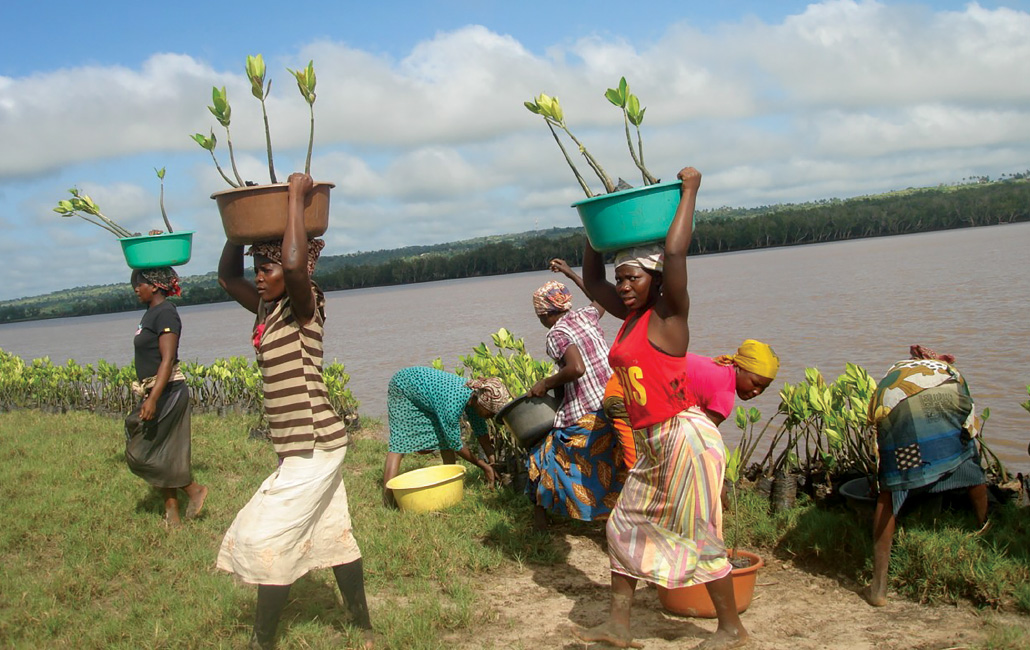
Blue economies
Less than 1 percent of Earth’s surface is covered by mangroves, equivalent to 14.8 million hectares. “Because this area is minuscule compared to terrestrial forests, mangroves have been neglected throughout the world,” says James Kairo, chief scientist at KMFRI.
At Gazi Bay, a 2011 assessment by the United Nations Environment Programme estimated that the mangrove forests are worth about $1,092 per hectare per year, thanks in part to the potential of fisheries, aquaculture, carbon sequestration and damages averted by the coastal protection that mangroves provide. Assuming that numbers in Gazi Bay hold for the rest of the world, mangroves could provide more than $16 billion in economic benefits planetwide.
Toward the end of 2020, Kenya’s government included mangroves and seagrasses for the first time in its Nationally Determined Contributions, or NDCs — the greenhouse gas emission reduction commitments for countries that ratified the Paris Agreement. The agreement seeks to limit global warming to below 2 degrees Celsius above preindustrial levels.
This inclusion commits Kenya to conserving mangroves to balance its emissions. Kenya’s government now “recognizes the potential and importance of the mangrove and seagrass resources that Kenya has,” Huxham says.
“This is a great commitment on the part of the government. The next challenge is the implementation of these commitments,” says Kairo, who sits on the advisory board of the U.N. Decade of Ocean Science for Sustainable Development (2021–2030), which aims to support efforts to reverse the cycle of decline in ocean health.
Now, scientists and community managers for that effort need to determine how mangroves can adapt to rising sea levels. “How can communities next to the sea live in harmony with this system, without impacting on their resiliency and productivity?” Kairo asks.
Mikoko Pamoja is helping provide answers, Kairo adds. Thanks in large part to that small project that began in a secluded corner on the Kenya coast, those answers are now spreading to the rest of the world.







